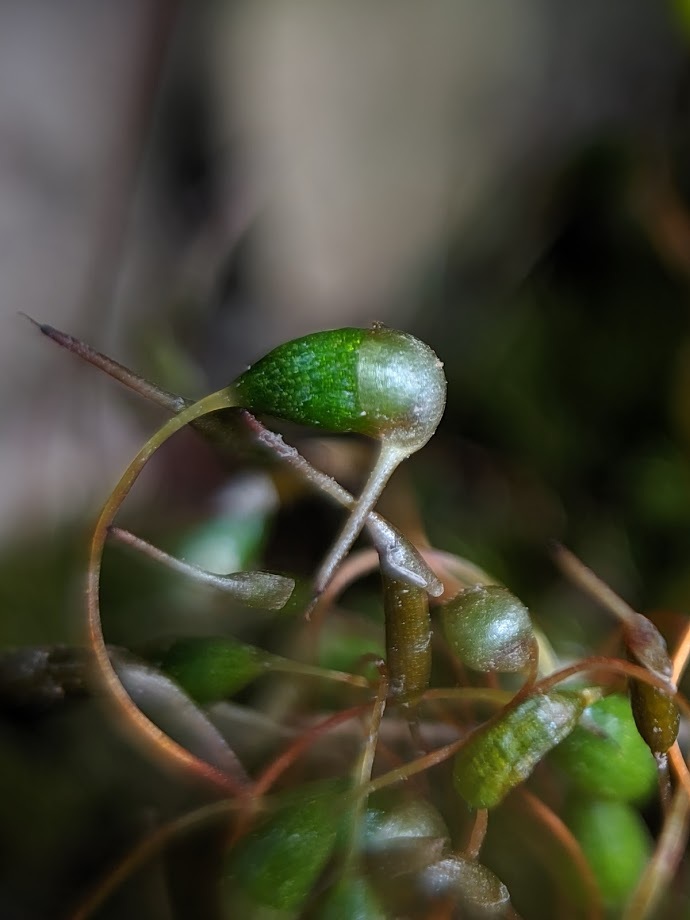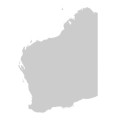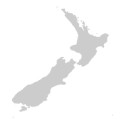Funaria
Autoicous or rarely polygamous (not in Victoria). Asexual propagules absent. Turves on soil, walls and burnt logs. Stems simple or with basal innovations, covered in rhizoids at base; central strand narrow. Leaves oblong-ovate to obovate, erect or erect-spreading when moist, little altered to contorted when dry; apex obtuse (not in Victoria), acute or acuminate, sometimes with an awn; costa subpercurrent, percurrent or excurrent; margins entire to serrulate in apical half, plane, without a border; laminal cells quadrate or rhombic- or oblong-hexagonal, becoming more oblong or rectangular toward base; alar cells not or scarcely differentiated. Setae curved, hygroscopic, yellow or red-brown, smooth. Capsules erect to pendent, strongly asymmetric to symmetric (not in Victoria), ovoid or pyriform, operculate, sulcate when dry, exserted, with a revoluble compound annulus. Calyptra cucullate, rostrate, smooth. Operculum plano-convex to low conic. Peristome double; exostome teeth sigmoid, fused at the apices by an ephemeral lattice disc; endostome segments rudimentary to equal in height of exostome teeth.
Cosmopolitan, but mostly restricted to high altitudes in the tropics, with fewer than 20 species (Fife 2019); two species in Victoria.
Uncertainty surrounded the boundaries between Funaria and Entosthodon. An asymmetric capsule and double peristome have been used to distinguish Funaria from Entosthodon (e.g. McIntosh 2007) or alternatively a different boundary defined by a compound and revoluble annulus for Funaria and a rudimentary annulus or no annulus for Entosthodon has been designated (e.g. Fife 1985). Phylogenetic analyses of DNA sequences from all genomic compartments support the latter circumscription (Liu et al. 2012; Medina et al. 2018). This circumscription is described here.
 Spinning
SpinningFife, A.J. (1985). A generic revision of the Funariaceae (Bryophyta: Musci) Part I . Journal of the Hattori Botanical Laboratory 58: 149–196.
Fife, A.J. (2019). Funariaceae, in Smissen, R & Wilton, A.D. (eds), Flora of New Zealand – Mosses. Fascicle 45. Manaaki Whenua Press, Lincoln.
Liu, Y.; Budke, J.M.; Goffinet, B. (2012). Phylogenetic inference rejects sporophyte based classification of the Funariaceae (Bryophyta): rapid radiation suggests rampant homoplasy in sporophyte evolution. Molecular Phylogenetics and Evolution 62: 130–145.
McIntosh, T.T. (2007). Funariaceae, in Flora of North America Editorial Committee (eds), Flora of North America, vol. 27: Bryophyta, part 1, pp. 180–199. Oxford University Press, New York and Oxford.
Medina, R.; Johnson, M.; Liu, Y.; Wilding, N.; Hedderson, T.A.; Wickett, N.; Goffinet, B. (2018). Evolutionary dynamism in bryophytes: Phylogenomic inferences confirm rapid radiation in the moss family Funariaceae. Molecular Phylogenetics and Evolution 120: 240–247.




